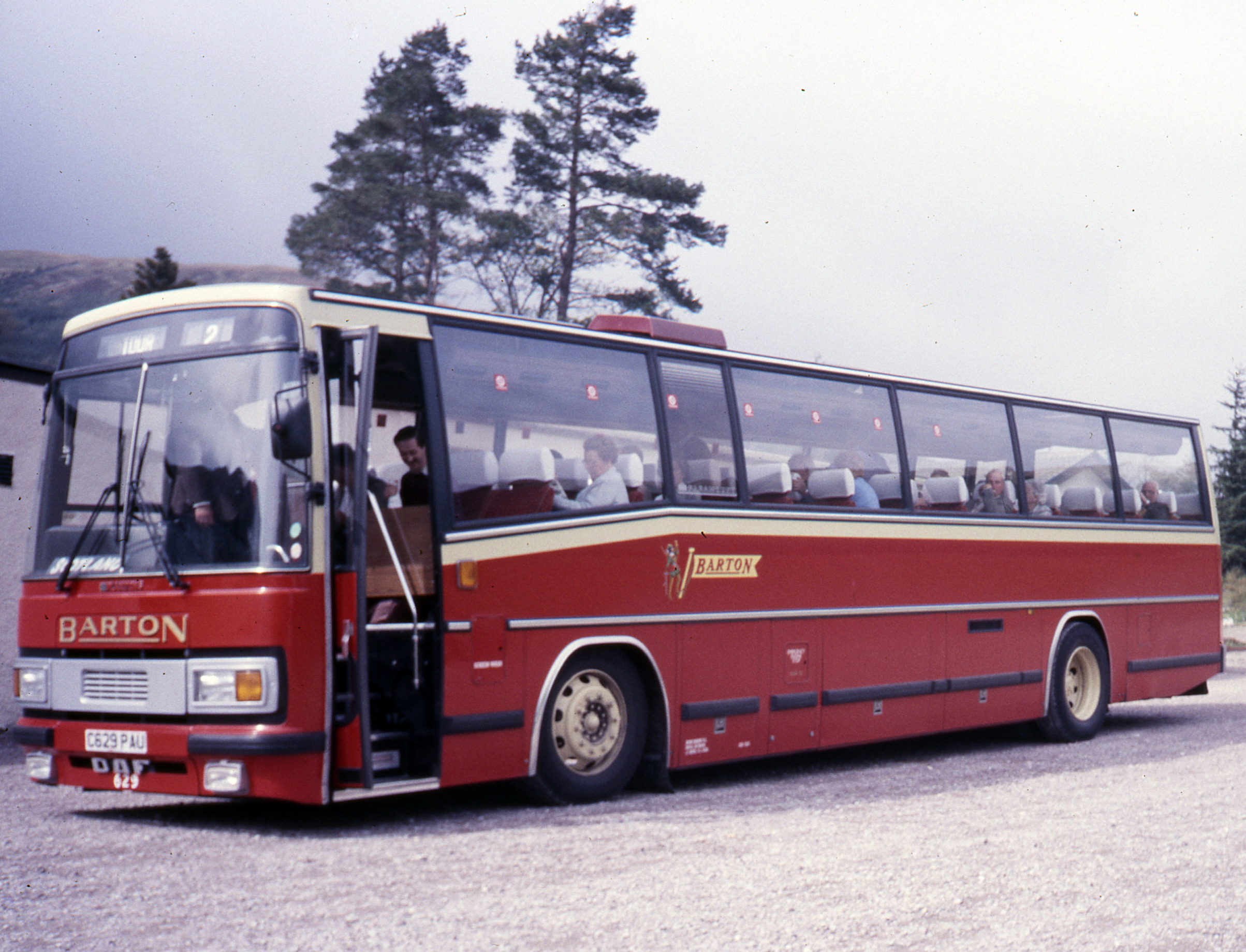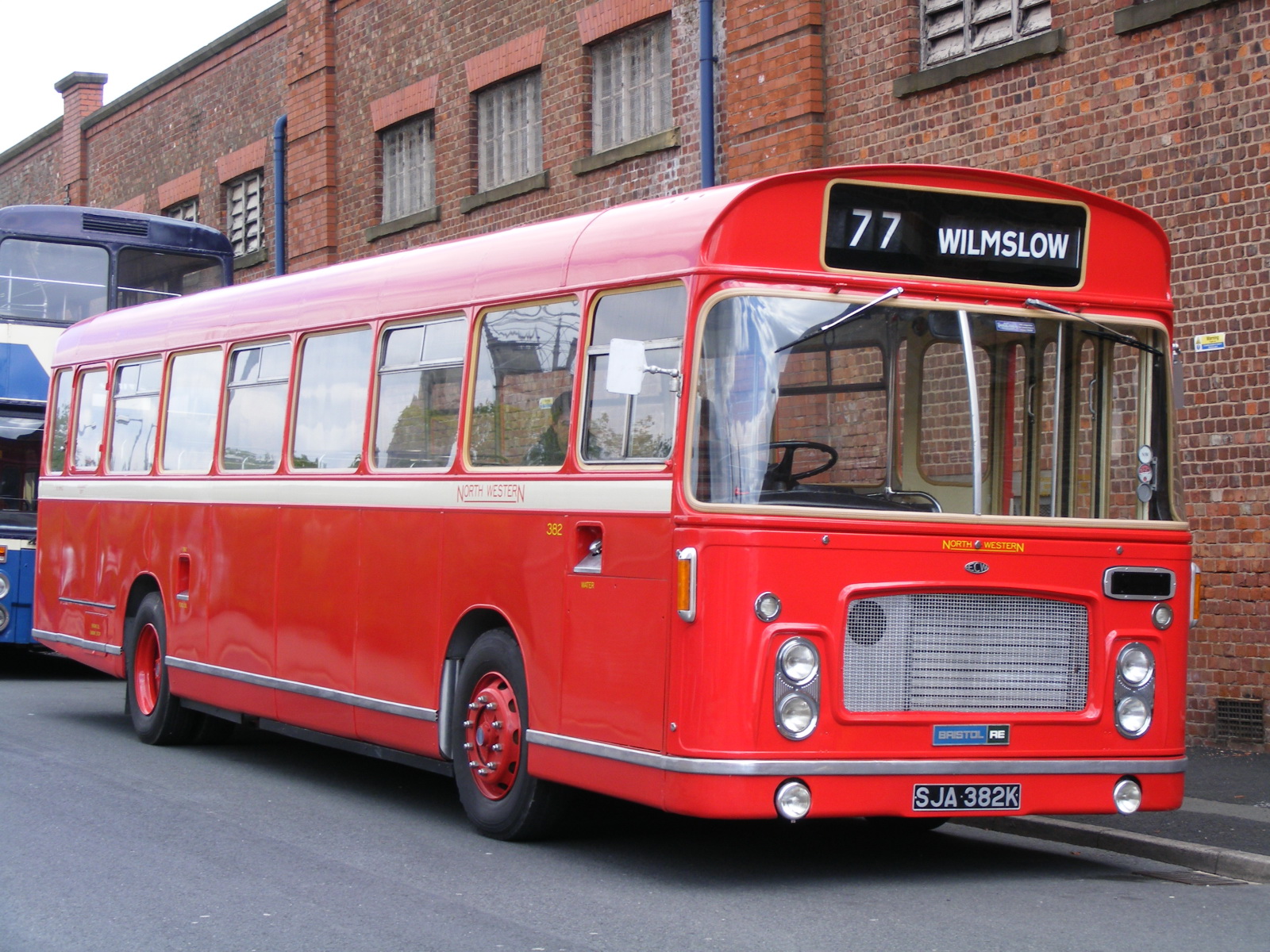|
Lowbridge Double-deck Bus
A lowbridge double-deck bus is a double-decker bus that has an asymmetric interior layout, enabling the overall height of the vehicle to be reduced compared to that of a conventional double-decker bus. The upper deck gangway is offset to one side of the vehicle, normally the offside (or driver's side), and is sunken into the lower deck passenger saloon. Low railway bridges and overpasses are the main reason that a reduced height is desired. Origins The lowbridge design was introduced and patented by Leyland in 1927 on their Titan TD1 chassis. Early examples were delivered to Glasgow Corporation amongst other operators. One of the Glasgow vehicles is preserved at the Scottish Vintage Bus Museum, Lathalmond, Fife. Disadvantages A major disadvantage of this layout was the inconvenient seating layout, with four-abreast seats upstairs making it difficult for passengers to manoeuvre past each other if those farthest from the gangway needed to alight first. A second disadvantage was ... [...More Info...] [...Related Items...] OR: [Wikipedia] [Google] [Baidu] |
Double-decker Bus
A double-decker bus or double-deck bus is a bus that has two storeys or decks. They are used for mass transport in the United Kingdom, the United States, New Zealand, Europe, Asia and also in cities such as Sydney; the best-known example is the red London bus, namely the AEC Routemaster. Early double-deckers put the driver in a separate cab. Passenger access was via an open platform at the rear and a bus conductor collected fares. Modern double-deckers have a main entrance door at the front and the driver takes fares, thus halving the number of workers aboard, but slowing the boarding process. The rear open platform, popular with passengers, was abandoned for safety reasons, as there was a risk of passengers falling when running and jumping onto the bus. Double-deckers are primarily for commuter transport, but open-top models are used as sight-seeing buses for tourists. William Gladstone, speaking of London's double-deck horse-drawn omnibuses, once observed that "...the best w ... [...More Info...] [...Related Items...] OR: [Wikipedia] [Google] [Baidu] |
Bristol VR
The Bristol VR was a rear-engined double-decker bus chassis which was manufactured by Bristol Commercial Vehicles as a competitor to the Leyland Atlantean and Daimler Fleetline. Development The Bristol VR was originally designed for single-deck or double-deck bodywork. The design featured a longitudinal mounted engine set behind the rear offside wheels, rather than the more typical transverse layout. A choice of Gardner 6LX or 6LW engines or the Leyland O.600 engine were to be available. The transmission was a semi-automatic unit by Self-Changing Gears. Originally intended to be designated the Bristol N-type, the chassis became known as the Bristol VR, an abbreviation for Vertical Rear, a reference to the layout of the engine. Two lengths were available, and , and these were designated VRS and VRL respectively. A drop-centre rear axle and low frame were employed to keep the height of the vehicle down. Two prototypes were built in spring 1966, and were shown at the 1 ... [...More Info...] [...Related Items...] OR: [Wikipedia] [Google] [Baidu] |
MK Metro
MK Metro was a bus company operating in Milton Keynes from 1997 until 2010. History In 1997, Stagecoach was ordered by the Office of Fair Trading to divest of its operations in Milton Keynes and Huntingdon. This followed an investigation in 1996 into its acquisition of Cambus Holdings which was deemed to have led to an unacceptable monopoly of bus operations in Cambridgeshire, Corby, East Northamptonshire, Kettering, Wellingborough, Bedford and Mid Bedfordshire. The assets of Milton Keynes Citybus were purchased on 2 May 1997 by bus entrepreneur Julian Peddle, using a new company Premier Buses Limited both to operate in Huntingdon (under the Premier Buses brand name) and also as a holding company with which to purchase MK Metro. The operation was rebranded as MK Metro with a bright yellow and blue livery introduced. In February 2006, the business was purchased by Arriva and integrated into its Arriva Shires & Essex subsidiary. The MK Metro brand was retained with a ... [...More Info...] [...Related Items...] OR: [Wikipedia] [Google] [Baidu] |
Stevensons Of Uttoxeter
Stevensons of Uttoxeter was a bus company that operated in Staffordshire from 1926 to 1997. History On 11 September 1926, John Stevenson commenced operating a bus service from Uttoxeter to Burton upon Trent. In 1971, the business passed to John's son George, who was shortly joined by his son David. In 1977, the fleet comprised 40 buses. In 1983, George sold his 50% share of the business to Julian Peddle. On 1 October 1985, Stevensons merged its bus operations with that of East Staffordshire District Council, with Stevenson and Peddle owning 51% and the council 49%. In 1987, Stevensons took a shareholding in Midland Fox including acquiring the Swadlincote depot.Arriva Midlands History Arriva In February 1992, Stevensons acquired a shareholding in [...More Info...] [...Related Items...] OR: [Wikipedia] [Google] [Baidu] |
Bedwas And Machen
Bedwas, Trethomas and Machen is a community and an electoral ward in the county borough of Caerphilly, constituting the villages of Machen, Trethomas, Bedwas, and Upper and Lower Graig-y-Rhacca. It lies in the Caerphilly Basin in the shadow of Mynydd y Grug and Mynydd Machen. All villages in the area grew as a result of the coal mining industry, which carries its legacy on today. History Bedwas and Machen Urban District was formed on 1 October 1912 from the parishes of Bedwas and Machen Upper, previously part of St Mellons Rural District. In 1935 the boundaries were altered when it exchanged areas with the neighbouring Mynyddislwyn Urban District. The urban district was abolished by the Local Government Act 1972, becoming part of Rhymney Valley District in Mid Glamorgan. On the abolition of the urban district, a community with identical boundaries was formed, and a community council established. On 16 March 1989 the community was renamed Bedwas, Trethomas and Machen. On ... [...More Info...] [...Related Items...] OR: [Wikipedia] [Google] [Baidu] |
Northern Counties Motor & Engineering Company
The Northern Counties Motor & Engineering Company was an English builder of bus and coach bodywork based in Wigan. History Northern Counties Motor & Engineering Company was founded in Wigan in 1919 by Henry Lewis. The Lewis family remained owners of the company until it was bought out over seventy years later. As was common at the time, early products were bodywork and repairs for private automobiles together with a tyre fitting service. By the early 1920s, the private automobile work had ceased and the manufacture of bodywork for service buses commenced. Bodywork was for both single and double deck vehicles. Very few coaches were produced. During World War II, Northern Counties was authorised by the government to produce bus bodies to a utility specification, mainly using steel-framed construction. Northern Counties established a loyal client base and reputation for quality construction in the post-war years. Notable clients included local operators SHMD Board, Mancheste ... [...More Info...] [...Related Items...] OR: [Wikipedia] [Google] [Baidu] |
Barton Transport
Barton TransportCompanies House extract company no 226122 Bartons Public Limited Company formerly Barton Transport plc was a bus company that operated in from 1908 until 1989. History 
Early years In October 1908, Thomas Henry Barton used a Durham Churchill charabanc to start the company's first service, between |
Dunham Massey
Dunham Massey is a civil parish in the Metropolitan Borough of Trafford, Greater Manchester, England. The parish includes the villages of Sinderland Green, Dunham Woodhouses and Dunham Town, along with Dunham Massey Hall and Park, formerly the home of the last Earl of Stamford and owned by the National Trust since 1976. Dunham Massey is in the historic county of Cheshire, but since 1974 has been part of Trafford Metropolitan Borough; the nearest town is Altrincham. At the 2001 census, the parish had a population of 475. Dunham Massey's history is reflected in its 45 listed buildings. It was a regionally important place during the medieval period, and the seat of the Massey barons. The Georgian mansion with the remains of a castle on its grounds is a popular tourist attraction. There are two Sites of Special Scientific Interest in Dunham Massey: Dunham Park, located south of Dunham Town, and Brookheys Covert. History The Roman road between Chester and York passing between ... [...More Info...] [...Related Items...] OR: [Wikipedia] [Google] [Baidu] |
Bridgewater Canal
The Bridgewater Canal connects Runcorn, Manchester and Leigh, Greater Manchester, Leigh, in North West England. It was commissioned by Francis Egerton, 3rd Duke of Bridgewater, to transport coal from his mines in Worsley to Manchester. It was opened in 1761 from Worsley to Manchester, and later extended from Manchester to Runcorn, and then from Worsley to Leigh. The canal is connected to the Manchester Ship Canal via a lock at Cornbrook; to the Rochdale Canal in Manchester; to the Trent and Mersey Canal at Preston Brook, southeast of Runcorn; and to the Leeds and Liverpool Canal at Leigh. It once connected with the River Mersey at Runcorn but has since been cut off by a slip road to the Silver Jubilee Bridge. Following the re-routing of roads to the Silver Jubilee Bridge, the Runcorn Locks Restoration Society campaigns to reinstate the flight of locks. The Bridgewater canal is described as the first great achievement of the canal age, although the Sankey Canal opened earlier. ... [...More Info...] [...Related Items...] OR: [Wikipedia] [Google] [Baidu] |
North Western Road Car Company (1923)
The North Western Road Car Company was a bus company in Stockport, England, formed in 1923 from the existing bus services of the British Automobile Traction Company Limited (itself a subsidiary of the British Electric Traction Company Limited) in Macclesfield. The company operated bus services in five counties (Cheshire, Lancashire, West Riding of Yorkshire, Derbyshire and Staffordshire) through a combination of growth and the acquisition of other bus companies, such as the takeover in 1924 of the Mid-Cheshire Motor Bus Company Limited, which brought new operations in Northwich and Flixton. The company also operated express coach services to London, North Wales and Yorkshire. North Western had garages in: * Altrincham: Oakfield Street * Biddulph: Whalley Street * Buxton: Bridge Street *Castleton, Back Street open till at least 1967 * Glossop: York Street * Macclesfield: Sunderland Street * Manchester: Hulme Hall Road * Matlock: Bakewell Road * Northwich: Chester Way * Oldham: C ... [...More Info...] [...Related Items...] OR: [Wikipedia] [Google] [Baidu] |
East Yorkshire Motor Services
East Yorkshire operates both local and regional bus services in the East Riding of Yorkshire and North Yorkshire, England. Prior to acquisition by the Go-Ahead Group in June 2018, the company was known as East Yorkshire Motor Services. History East Yorkshire Motor Services was originally made up of two companies, Lee & Beaulah (set up by Ernest John Lee) and Hull & District Motor Services (set up by H.A. Harvey). In October 1926, British Electric Traction purchased the two companies. In 1968, the British Electric Traction group was sold to the Transport Holding Company, which in turn became the National Bus Company in the following year. Until 1972, the company's livery was dark blue with a primrose band, with a white relief band also applied to the roofline of buses. Shortly after East Yorkshire was brought under National Bus Company ownership, the primrose band was changed to white and buses were given NBC corporate fleet names. This proved to be short-lived, with the adapte ... [...More Info...] [...Related Items...] OR: [Wikipedia] [Google] [Baidu] |






